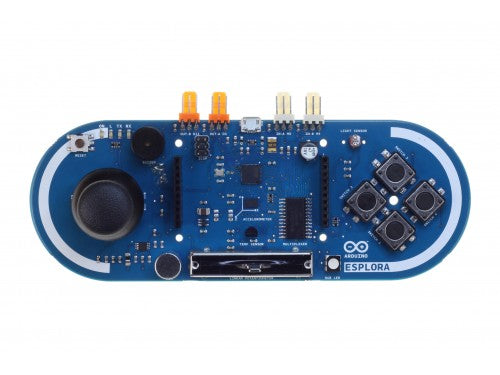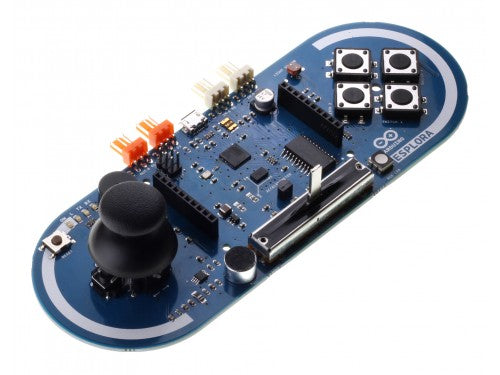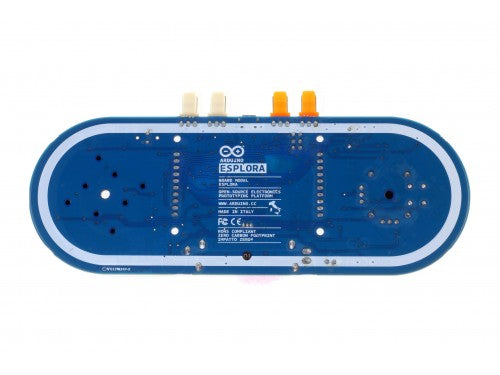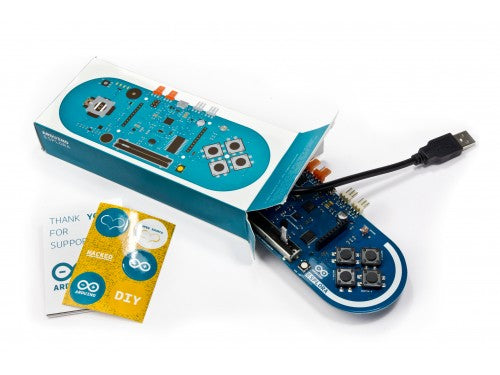Beschreibung
Das Arduino Esplora ist ein auf Arduino Leonardo basierendes Board mit integrierten Sensoren und Aktoren
Der Arduino Esplora ist ein Mikrocontroller-Board, das vom Arduino Leonardo abgeleitet ist. Das Esplora unterscheidet sich von allen vorhergehenden Arduino-Boards dadurch, dass es eine Reihe von eingebauten, sofort einsatzbereiten Onboard-Sensoren für die Interaktion bietet. Es wurde für Leute entwickelt, die mit Arduino in Betrieb gehen wollen, ohne sich erst mit der Elektronik vertraut machen zu müssen. Eine Schritt-für-Schritt-Einführung in das Esplora finden Sie im Leitfaden Getting Started with Esplora.
Die Esplora hat ein onboard Ton- und Lichtausgänge und mehrere Eingangssensoren, darunter einen Joystick, einen Schieberegler, einen Temperatursensor, einen Beschleunigungsmesser, ein Mikrofon und einen Lichtsensor. Sie hat auch das Potenzial, ihre Fähigkeiten mit zwei Tinkerkit-Eingangs- und Ausgangsanschlüssen und einem Sockel für einen TFT-LCD-Farbbildschirm zu erweitern.
Wie das Leonardo-Board, verwendet das Esplora einen AVR-Mikrocontroller Atmega32U4 mit einem 16-MHz-Kristalloszillator und einem Mikro-USB-Anschluss, der als USB-Client-Gerät fungieren kann, wie eine Maus oder eine Tastatur.
In der linken oberen Ecke der Platine befindet sich ein Reset-Knopf, mit dem Sie die Platine neu starten können. Es gibt vier Status-LEDS :
ON [grün] zeigt an, ob die Karte mit Spannung versorgt wird.
L [gelb] direkt an den Mikrocontroller angeschlossen, zugänglich über Pin 13
RX und TX [gelb] zeigt die Daten an, die über die USB-Kommunikation gesendet oder empfangen werden
Das Board enthält alles, was zur Unterstützung des Mikrocontrollers benötigt wird; schließen Sie es einfach mit einem USB-Kabel an einen Computer an, um loszulegen.
Der Esplora hat eine eingebaute USB-Kommunikation; er kann einem angeschlossenen Computer als Maus oder Tastatur erscheinen, zusätzlich zu einem virtuellen (CDC) seriellen / COM-Port. Dies hat weitere Auswirkungen auf das Verhalten des Boards; diese sind auf der Seite "Erste Schritte" im Detail beschrieben.
Hier finden Sie die Garantieinformationen Ihres Boards.
Brauchen Sie Hilfe?
Technische Details
- Mikrocontroller: ATmega328P
- Betriebsspannung: 5V
- Eingangsspannung (empfohlen): 7-12V
- Eingangsspannung (Grenzwert): 6-20V
- Digitale E/A-Pins: 14 (davon 6 mit PWM-Ausgang)
- PWM-Digital-E/A-Stifte: 6
- Analoge Eingangspins: 6
- DC-Strom pro E/A-Pin: 20 mA
- DC-Strom für 3,3V Pin: 50 mA
- Flash-Speicher: 32 KB (ATmega328P), davon 0,5 KB für den Bootloader
- SRAM: 2 KB (ATmega328P)
- EEPROM: 1 KB (ATmega328P)
- Taktfrequenz: 16 MHz
- LED_BUILTIN: 13
- Länge 68,6 mm
- Breite 53,4 mm
- Gewicht 25 g
Description
The Arduino Esplora is a board based on Arduino Leonardo with integrated sensors and actuators.
The Arduino Esplora is a microcontroller board derived from the Arduino Leonardo. The Esplora differs from all previous Arduino boards in that it provides a set of built-in, out-of-the-box, onboard sensors for interaction. It's designed for people who want to get up and running with Arduino without having to learn the electronics first. For a step-by-step introduction to the Esplora, see the Getting Started with Esplora guide.
The Esplora has onboard sound and light outputs and multiple input sensors, including a joystick, slider, temperature sensor, accelerometer, microphone, and light sensor. It also has the potential to expand its capabilities with two Tinkerkit input and output connectors and a socket for a color TFT LCD screen.
Like the Leonardo board, the Esplora uses an Atmega32U4 AVR microcontroller with a 16 MHz crystal oscillator and a micro USB port that can act as a USB client device, like a mouse or keyboard.
There is a reset button in the upper left corner of the board, which you can use to reboot the board. There are four status LEDs :
ON [green] indicates if the board is powered.
L [yellow] directly connected to the microcontroller, accessible via pin 13
RX and TX [yellow] indicates data being sent or received via USB communication.
The board includes everything needed to support the microcontroller; just connect it to a computer with a USB cable to get started.
The Esplora has built-in USB communication; it can appear to a connected computer as a mouse or keyboard, in addition to a virtual (CDC) serial / COM port. This has further implications for the behavior of the board; these are described in detail on the Getting Started page.
You can find your board's warranty information here.
Need help?
- About the software on the Arduino forum
- About projects on the Arduino forum
Technical details
- Microcontroller: ATmega328P
- Operating voltage: 5V
- Input voltage (recommended): 7-12V
- Input voltage (limit): 6-20V
- Digital I/O pins: 14 (including 6 with PWM output)
- PWM digital I/O pins: 6
- Analog input pins: 6
- DC current per I/O pin: 20 mA
- DC current for 3.3V pin: 50 mA
- Flash memory: 32 KB (ATmega328P), thereof 0.5 KB for the bootloader
- SRAM: 2 KB (ATmega328P)
- EEPROM: 1 KB (ATmega328P)
- clock frequency: 16 MHz
- LED_BUILTIN: 13
- length 68,6 mm
- width 53,4 mm
- Weight 25 g
Sicherheitsangaben
- Lesen Sie die Bedienungsanleitung sorgfältig durch, bevor Sie das Produkt verwenden.
- Stellen Sie sicher, dass alle Montage- und Installationsanweisungen des Herstellers sorgfältig befolgt werden.
- Verwenden Sie das Produkt nur für den vorgesehenen Zweck.
- Die unsachgemäße Nutzung dieses Produkts kann zu schweren Verletzungen oder Sachschäden führen.
- Nicht für Kinder unter 10 Jahren geeignet.
- Bei unsachgemäßer Verwendung besteht eine Verletzungsgefahr.
- Dieses Produkt entspricht den geltenden Sicherheitsanforderungen der Europäischen Union.
- Dieses Produkt wurde gemäß der GPSR geprüft, die sicherstellt, dass alle relevanten Sicherheitsanforderungen für Konsumgüter eingehalten werden.
Nachverfolgbarkeitsinformationen
Jedes Produkt verfügt über eines oder mehrere der folgenden Merkmale:
- Ein CE-Kennzeichen, das die Einhaltung der Sicherheits-, Gesundheits- und Umweltschutzanforderungen der Europäischen Union anzeigt.
- Eine eindeutige Serien- oder Chargennummer, um die Nachverfolgbarkeit zu gewährleisten und bei Bedarf Rückrufaktionen zu unterstützen.
- Hersteller- und Importeurangaben für den Kundensupport und Sicherheitsanfragen.
Überwachung und Berichterstattung von Vorfällen
Für den unwahrscheinlichen Fall eines Produktproblems haben wir Verfahren implementiert, um:
- Kundenbeschwerden zeitnah bearbeiten.
- Schwerwiegende Vorfälle über das EU Safety Gate/RAPEX-System melden.
- Mit den Marktüberwachungsbehörden zusammenarbeiten, um die öffentliche Sicherheit zu gewährleisten.
Kontakt:
- Email: support [@] pi3g.com
- Telefon: 0341 / 392 858 40
Dieses Produkt ist vollständig mit allen geltenden EU-Vorschriften konform, um die Sicherheit unserer geschätzten Kunden zu gewährleisten.




